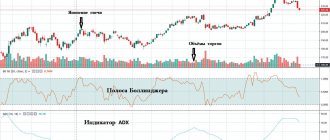When a person with a sufficient amount of personal capital decides to become a private investor and gain access to trading on the stock market, he turns to a broker.
The broker, noticing that the client who contacted him has little knowledge in the field of stock trading, will definitely offer to attend training courses. But it very often happens that attending courses costs a lot of money, and a novice private investor may simply not have enough free time to attend them, since a novice investor, as a rule, has a main type of employment and it is not advisable to leave it for new endeavors.
Admission of shares to trading on the stock exchange
To be admitted to trading on an exchange, shares must undergo a listing procedure or be admitted to trading without undergoing a listing procedure.
Participation of shares in trading allows the issuer to attract the cheapest and longest-term capital, increase the value of the company, reduce the cost of borrowing, increase its prestige, carry out additional advertising through exchange channels and successfully place subsequent issues.
Types of share prices
The par value of a stock is what is written on its face (sometimes called face value ). The total amount of the authorized capital is equal to the total par value of all issued shares.
The par value of all ordinary shares of the company must be the same.
The par value does not have to reflect the actual value of the shares. However, it is often used for a number of operations (assessment of duties, commissions, tariffs), especially in an undeveloped, low-liquid stock market. The price of shares at the initial placement should not be lower than the par value.
The issue price of a share is the price of shares at their initial placement at which the first holder purchases it. Typically, the issue price of a share is greater than or equal to its par value. The excess of the issue price over the nominal value is called issue proceeds, or share premium.
The market value of a stock is the price at which the stock is bought and sold in the secondary market. The market price (rate) is usually formed during trading on the stock exchange and reflects the balance of supply and demand for these shares. The level of liquidity of the stock market is important for the formation of market prices. Indirectly, the market value of shares reflects the liquidation value of the company's assets and liabilities.
Book value of shares is the quotient of the company's net asset value (book value of the company) divided by the number of issued shares outstanding. If the market price is lower than the book price, then this is the basis for future stock price growth. Typically, the book value is determined during audits.
Stock Valuation Methods
In world practice, many methods are used to determine the price of shares, the most common of which are:
- method of assessment based on expected profitability;
- valuation method based on constant dividend growth;
- modified stock valuation model.
Typically, valuation is carried out by investment banks or independent analytical agencies that provide independent stock price analytics.
Exchange difference
Trading shares can also bring good income - provided that you choose securities that rapidly change in value.
Here, earnings are accrued in the form of the difference after purchase/sale transactions are completed. Most often, for such earnings, they choose ordinary shares or startups, which are growing rapidly and can provide enormous profits in the shortest possible time.
It should be mentioned here that after the registry is closed, the share price is reduced by the amount of certain dividends.
This is a good time to buy, but a bad time to sell. After 3-6 months, the price returns to its previous level (subject to stable operation of the company, absence of crises, etc.).
Investment properties of shares
A share is an instrument for investing capital; it belongs to equity securities. The investment potential of shares depends on a number of characteristics, the main of which are the financial condition of the issuer, reliability, liquidity and profitability.
The investment opportunities of ordinary shares are related to the fact that they can be traded on the exchange or over-the-counter market and generate income not only in the form of dividends, but also due to changes in value over different periods of time. Fluctuations in value can be very significant and significantly exceed the amount of dividends. Many joint stock companies do not pay dividends, but the value of their shares can increase several times.
Conclusion
Every person interested in increasing their income through the stock exchange should understand who a shareholder and investor is. Successful practice is impossible without basic knowledge. This will not only protect a novice entrepreneur from making wrong decisions, but will also allow him to take the first step as efficiently as possible, even with minimal starting capital.
Do you think it is possible to start stock trading without theory, relying only on intuition? Share your expert opinion in the comments.
Rate this article:
[Total: 11 Average: 4.6/5] (Article Rating: 4.6 out of 5)
Author of the article Anna Gromova Accountant
Company shares
A company's block of shares is the number of shares of one joint stock company (JSC) in the same hands or under single control. The value of large blocks of shares can increase many times over if their ownership allows you to influence the activities of the company.
Usually 5% of shares is enough to convene a general meeting of shareholders; 25% - most decisions of the general meeting can be blocked; in practice, for large joint-stock companies, 20-30% of shares is sufficient; more than 50% provides complete control over the company’s activities.
A stock premium is a premium to the share price received by the seller of a block for increasing the management power of the buyer of the block.
A blocking stake is a share of shares that allows its owners to veto decisions of the board of directors of a joint-stock company. Typically, the blocking stake is more than a quarter (25%) of all shares - that is, ownership of such a number of shares that allows you to block any decision made by the joint-stock company if it does not suit such a shareholder.
For example, if the charter of a joint-stock company stipulates that a decision on such and such an issue can be made by a qualified majority of, say, three-quarters of the votes, then the blocking stake will be 25% of the shares + 1 share. Theoretically, the share of shares required for blocking is 25%, but in practice it is less.
A controlling stake is a share of shares that gives its owner the opportunity to independently make decisions regarding the functioning of the joint-stock company, including appointing management.
The unconditional controlling interest is 50% + 1 share. But in most companies, decisions at the general meeting are made by a majority vote of those present.
The larger the company and the more widespread its shares are among minority shareholders, the higher the likelihood that a significant portion of shareholders will not be present at the general meeting. In such a situation, a majority vote can provide a significantly smaller package. For example, for US corporations, the controlling stake is on average no more than 20%, and often 5-10%.
General rights
When purchasing a security, the investor is given certain rights. In the case of ordinary shares, the owner has the following options and can:
- take part in the management of the issuing enterprise through voting. The most important decisions are made at general meetings of the joint-stock company, which, if necessary, can be convened several times during the year;
- receive the required dividends. The decision on their payment and amount is made by the Board of Directors and submitted for discussion to the meeting of shareholders. The Meeting may approve the Council's recommendations or reduce payment amounts;
- sell securities at any time. This is easy to do, since these are assets that meet all exchange conditions. Alternatively, you can sell them through a private transaction;
- increase the volume of your investments through dividends and the purchase and sale of securities;
- receive a share of the issuing company’s property upon its liquidation. However, this right can be used only after the rights of borrowers and owners of preferred securities are satisfied;
- receive compensation in the event of a merger or acquisition by another company. Typically, with such compensation, securities are redeemed from holders or shares of a new enterprise are issued.
Stocks and Bonds
The equity risk premium must be maintained over the long term to ensure the efficiency of the overall economic system. In a capitalist economy, bonds cannot and should not outperform stocks over the long term.
A bond is a contract whose performance is guaranteed by the government. Shares, on the other hand, do not guarantee anything to their holders - they are a risky investment that requires a higher degree of confidence in the future. So stocks are not inherently better than bonds, but we need higher returns from stocks to compensate for their higher risk.
If the expected long-term return on bonds were higher than the long-term expected return on stocks, asset prices would be set so that investors would not be rewarded for risk.
This situation cannot last long. Stocks must remain the best investment asset for anyone seeking sustainable returns over the long term, otherwise the economic system will collapse.
What to remember
- By purchasing a share, you become a co-owner of the business.
- There are two types of shares: ordinary and preferred. When purchasing preferred shares, you are entitled to dividends. If you invest in common stock, you are given the right to vote on matters relating to the internal affairs of the company.
- You should remember that investing in shares carries the risk of loss of capital.
- You can buy shares on the stock market. To do this, you need a reliable broker with a stable history of presence on the market.
- If you decide to invest in stocks, remember the basic rules of investing: diversify your portfolio, follow news and analytics, create a “safety cushion” and do not react to panic around stocks.
- #Stock
- #Tips for beginners
Was the article helpful?
Thanks for the answer!
Books about stocks
1) Jeremy Siegel - Long-term investing in stocks. Strategies with high income and reliability, 2010. St. Petersburg.
2) Large economic dictionary . – Ed. A.N. Azriliyana. – 6th edition, – M.: Institute of New Economics, 2004. – 1376 p. – page 30.
3) Martin D. Weiss - Make money during a stock market crisis. – St. Petersburg: Leader, 2009. – 384 p. ISBN 978-5-49807-311-8. (Martin D. Weiss - Crash Profits: Make Money when Stocks Sink and Soar, Wiley 2003, ISBN 0-471-42998-8).
4) Alexey Burenin - Problems with solutions on the securities market, derivatives market and risk management (3rd edition) - 380 pages - Weight: 960 g. - Publisher: NTO im. Academician S.I. Vavilova (2012) - 1280 rubles - ISBN: 978-5-905094-05-7. Chapter 3: Shares and stock indices (determining market value, profitability; margin trading, splitting shares).









